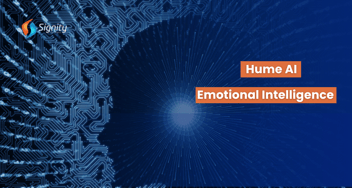AI Enhanced Virtual Reality: Redefining Experiences
AI-Enhanced Virtual Reality ushers in a transformative era, seamlessly blending artificial intelligence with immersive technologies. This fusion redefines virtual experiences, offering unprecedented interactivity and a dynamic journey that blurs the lines between the digital and physical realms.
.png?width=670&height=445&name=AI%20Enhanced%20Virtual%20Reality%20(1).png)
Virtual Reality (VR) has undergone remarkable advancements in recent years, propelling it from a niche technology to a mainstream phenomenon. As VR becomes more accessible, the integration of Artificial Intelligence (AI) has emerged as a transformative force, amplifying the immersive potential of virtual experiences.
This synergy between AI and VR not only revolutionizes entertainment but extends its impact to education, healthcare, and various other domains. In this article, we delve into the intricacies of AI-enhanced virtual reality, exploring how this technological convergence is reshaping our digital interactions and redefining the boundaries of immersive experiences.
The Evolution of Virtual Reality
Virtual Reality, once confined to the realms of science fiction, has evolved into a sophisticated technology that immerses users in computer-generated environments. The evolution of VR hardware, from early prototypes to consumer-ready headsets, has paved the way for widespread adoption. However, the true potential of VR is unlocked when combined with the intelligence and adaptability of Artificial Intelligence.
The Role of AI in VR Immersion
At the core of the synergy between AI and VR is the quest for heightened immersion. AI algorithms, particularly those driven by machine learning, can analyze and respond to user behavior in real-time. This adaptability allows VR environments to dynamically adjust, creating a more personalized and engaging experience.
For example, imagine exploring a virtual forest where AI algorithms analyze your movements, gaze patterns, and interactions. The environment responds to your preferences, altering the scenery, adjusting the level of challenge, and even anticipating your next move. This level of dynamic interaction transcends traditional VR experiences, blurring the lines between the digital and physical worlds.
Natural Language Processing (NLP) in VR:
One of the most compelling aspects of AI in VR is the integration of Natural Language Processing (NLP). An audio notetaker ensures all voice-based interactions in VR sessions are captured and easily searchable. This technology enables users to communicate with virtual environments using natural spoken language, fostering a more intuitive and life-like interaction. In VR applications, this means that users can engage in conversations, issue commands, or seek information using their voice, eliminating the need for traditional input devices.
Applications in VR Education:
The fusion of NLP and VR has great potential for education. In virtual classrooms, AI tutors using NLP respond to student queries, providing personalized guidance. Tailored educational experiences, adapting to individual learning styles, are facilitated by AI in VR. Language learning particularly benefits, as NLP in VR allows users to practice with AI characters, enhancing language skills dynamically in an immersive environment.
Gesture Recognition and AI:
Another facet of AI-enhanced VR is gesture recognition, where machine learning algorithms interpret hand movements and gestures to facilitate interaction within virtual environments. This technology not only adds to the realism of VR experiences but also provides a more natural and intuitive means of engagement.
Consider a scenario where architects use hand gestures to manipulate virtual 3D models in a design application. AI interprets these gestures, translating them into actions within the virtual space. This intuitive interaction fosters creativity and streamlines design processes, making AI-enhanced VR a valuable tool in fields such as architecture, design, and engineering.
Realizing Inclusive Gaming Experiences:
In the realm of gaming, gesture recognition and AI contribute to creating more inclusive experiences. Traditional controllers may pose challenges for some users, but AI-driven gesture recognition opens the door to alternative input methods. Players can control characters, navigate virtual worlds, and interact with objects using hand movements, enhancing accessibility for a broader audience.
Adaptive Learning and Personalization:
AI's capacity to analyze user behavior over time brings forth the concept of adaptive learning in VR. Machine learning algorithms observe and understand individual preferences, learning styles, and performance patterns. This wealth of data is then utilized to tailor the VR experience, presenting content, challenges, and scenarios that align with the user's unique characteristics.
Personalized Healthcare Training Simulations:
AI-enhanced VR simulations in healthcare offer personalized training for medical professionals. Virtual surgeries, realistic patient scenarios, and skill refinement occur in a risk-free environment. AI adjusts scenario difficulty based on proficiency, ensuring challenging and beneficial training. Additionally, adaptive learning in VR can personalize therapeutic interventions based on patient progress, enhancing the effectiveness of healthcare applications.
Collaboration and Social Interaction:
AI-driven avatars and social interaction algorithms are reshaping how individuals collaborate and socialize in virtual spaces. The sophistication of AI algorithms enables avatars to exhibit realistic behaviors, expressions, and even emotions, enriching the social experience within VR.
Redefining Remote Collaboration:
As remote work becomes increasingly prevalent, AI-powered avatars can bridge the gap between physical separation and a sense of presence. In virtual meetings or collaborative workspaces, these avatars can mimic real-world interactions, analyzing speech patterns and body language to simulate natural communication. The result is a more immersive and engaging collaboration experience, making remote interactions feel more akin to face-to-face meetings.
AI-Enhanced Social VR Experiences:
Beyond the workplace, AI contributes to the evolution of social VR experiences. Virtual worlds equipped with intelligent NPCs (non-player characters) can facilitate more meaningful and dynamic interactions.
AI analyzes user preferences and behaviors, creating virtual environments that adapt to the collective interests of the participants. Whether it's exploring a virtual museum, attending a virtual concert, or engaging in social activities, AI enhances the richness of these experiences, making them more enjoyable and memorable.
Challenges and Ethical Considerations
While the fusion of AI and VR holds tremendous potential, it is not without its challenges and ethical considerations. Addressing these concerns is essential to ensure the responsible development and deployment of AI-enhanced virtual reality technologies.
Privacy and Data Security:
VR environments collect extensive user data for a richer experience, including gaze patterns and hand movements. Balancing data collection for improvement with user privacy is a key challenge. Developers must navigate this by implementing robust data protection, transparent policies, and anonymization techniques to build and maintain user trust.
Bias and Fairness:
AI algorithms, if not carefully designed and trained, can perpetuate biases present in their training data. In the context of VR, this could lead to biased representations of virtual environments or AI-driven characters. Developers must be vigilant in identifying and mitigating biases, ensuring that VR experiences are inclusive and free from discriminatory practices.
Ethical Use of AI in VR Content:
The immersive nature of VR can evoke strong emotional responses from users. Developers must exercise caution in creating content that respects users' emotional well-being. Content that induces distress, fear, or harm should be approached with ethical considerations in mind. Establishing industry-wide ethical guidelines for AI-enhanced VR content is crucial to maintaining user safety and fostering a positive virtual experience.
The Future of AI-Enhanced Virtual Reality
As we navigate the exciting intersection of AI and VR, the future holds boundless possibilities. From the continued refinement of immersive experiences to the development of new applications across various industries, the trajectory is marked by innovation and exploration.
AI-Powered Creativity in VR:
AI is not merely a tool for enhancing existing VR experiences; it is a catalyst for the creation of entirely new and unimaginable virtual worlds. Generative AI algorithms can autonomously generate virtual landscapes, characters, and scenarios, pushing the boundaries of creativity in VR content creation. This promises a future where AI collaborates with human creators, co-authoring immersive narratives and pushing the limits of virtual storytelling.
AI-Driven Health and Wellness Applications:
The healthcare industry stands to benefit significantly from the integration of AI and VR. As technology advances, we can expect the development of AI-driven health and wellness applications in VR. From therapeutic interventions for mental health to immersive wellness experiences, the combination of AI and VR could revolutionize how we approach healthcare and well-being.
Advancements in AI-Enhanced Training Simulations:
Training simulations across various fields, from aviation to manufacturing, will witness continuous advancements driven by AI. Adaptive learning algorithms will become more sophisticated, enabling highly personalized and realistic training experiences. The integration of AI will not only improve the effectiveness of these simulations but also contribute to reducing training costs and increasing accessibility.
Social VR as a Mainstream Communication Platform:
The integration of AI-driven avatars and social interaction algorithms could propel social VR experiences into the mainstream. Virtual gatherings, conferences, and social activities may become a staple of how people communicate and connect, transcending physical distances. As technology continues to advance, the line between the physical and virtual worlds may blur, redefining our notions of social interaction and connectivity.
Conclusion
The fusion of AI and VR transforms how we experience digital environments, offering heightened immersion, adaptive learning, and collaborative spaces. Navigating this landscape requires careful consideration of challenges and ethics.
Embrace AI Excellence
Contact our team to explore tailored AI solutions that can boost your business growth.
Responsible development ensures societal benefits, paving the way for AI to shape creative processes and unlock new realms of possibility in immersive experiences. The evolving technology promises a thrilling journey into AI-enhanced virtual reality, expanding horizons and reshaping our digital landscape.


%201-1.webp?width=148&height=74&name=our%20work%20(2)%201-1.webp)


.png?width=344&height=101&name=Mask%20group%20(5).png)
















